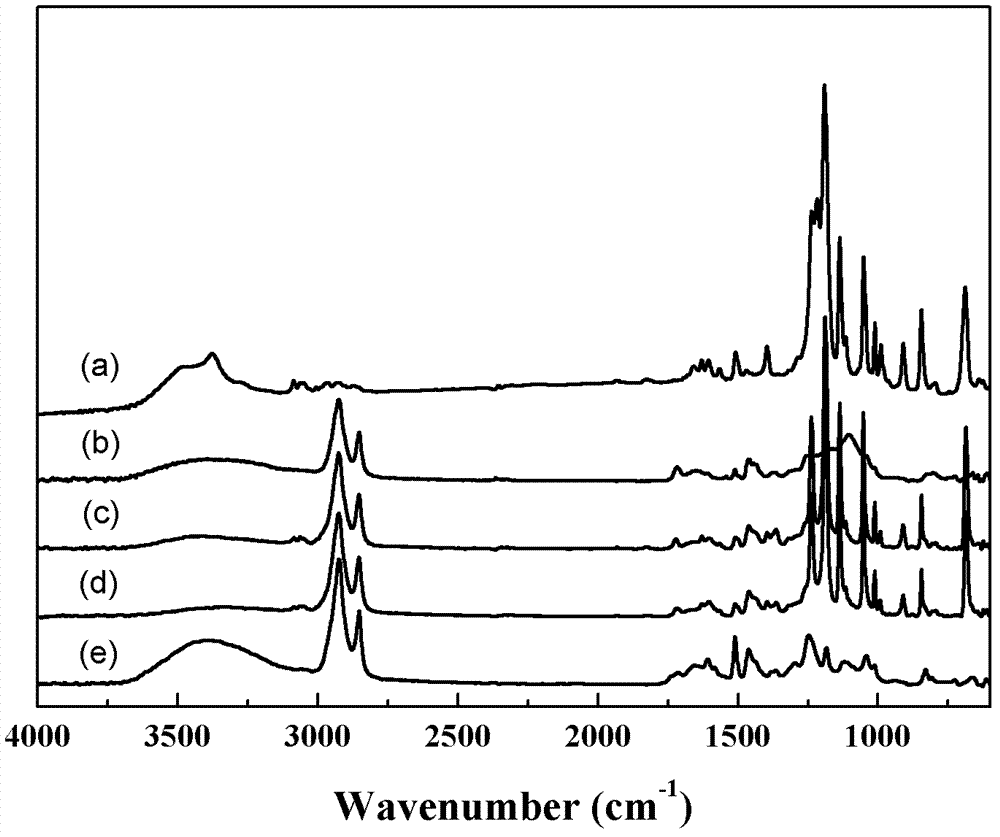Preparation method of polymer matrix proton exchange membrane (PEM) with cross-linked structure
A technology of proton exchange membrane and cross-linked structure, which is applied in structural parts, fuel cell parts, battery pack parts, etc., can solve the requirements of high film forming conditions, poor controllability of sulfonation degree and sulfonation position , easy to cause pollution and other problems, to achieve the effect of reducing methanol permeability, low methanol permeability coefficient, and meeting the requirements of use
- Summary
- Abstract
- Description
- Claims
- Application Information
AI Technical Summary
Problems solved by technology
Method used
Image
Examples
Embodiment 1
[0025] Preparation of SBR / NaSS composite film: Add 100g SBR to the open mill at room temperature to make it roll, then add 50g NaSS, 4g peroxide DBPMH, 1g crosslinking aid TAIC in turn; add all of them and mix for 10 minutes , make a triangular bag, and slice evenly to obtain a mixed rubber. Put the mixed rubber in the mold, pressurize and exhaust, press at 160°C for 15 minutes (the in-situ grafting reaction occurs within this period), take out the mold, and obtain the SBR / NaSS composite film.
[0026] The SBR / NaSS composite film was first soaked in deionized water for 24 hours at 50°C, and then soaked in a sulfuric acid solution with a mass fraction of 5% for 30 hours; then, the film was cleaned with deionized water at room temperature until the pH value is 6-7. The washed films were vacuum dried at 70 °C for 24 h to remove moisture. Finally, SBR-based PEM with cross-linked structure was obtained.
Embodiment 2
[0028]Preparation of EPDM / NaVS composite film: Add 100g EPDM to the open mill at room temperature to make it roll, then add 50g NaVS, 8g peroxide DCP, 2g cross-linking agent TAC in turn; add all of them and mix for 10 minutes , make a triangular bag, and slice evenly to obtain a mixed rubber. Put the mixed rubber in the mold, pressurize and exhaust, press at 170°C for 30 minutes (the in-situ grafting reaction occurs within this period), take out the mold, and obtain the EPDM / NaVS composite film.
[0029] The EPDM / NaVS composite film was first soaked in deionized water for 20 hours at 70°C, and then soaked in a sulfuric acid solution with a mass fraction of 15% for 24 hours; then, the film was cleaned with deionized water at room temperature until the pH value is 6-7. The washed films were vacuum-dried at 100 °C for 12 h to remove moisture. Finally, EPDM-based PEM with cross-linked structure was obtained.
Embodiment 3
[0031] Preparation of CSM / NaSS composite film: add 100g CSM to the open mill at room temperature to make it roll, then add 100g NaSS, 14g peroxide DCP, 3g crosslinking agent HVA-2 in turn; add all of them and mix After 30 minutes, make a triangular bag, and then slice evenly to obtain a mixed rubber. Put the mixed rubber in the mold, pressurize and exhaust, press at 170°C for 45 minutes (the in-situ grafting reaction occurs within this period), take out the mold, and obtain the CSM / NaSS composite film.
[0032] The CSM / NaSS composite film was soaked in deionized water for 30 hours at 60°C, and then soaked in a sulfuric acid solution with a mass fraction of 10% for 24 hours; then, the film was cleaned with deionized water at room temperature until the pH value is 6-7. The washed films were vacuum-dried at 100 °C for 12 h to remove moisture. Finally, a CSM-based PEM with a cross-linked structure was obtained.
PUM
| Property | Measurement | Unit |
|---|---|---|
| quality score | aaaaa | aaaaa |
| quality score | aaaaa | aaaaa |
Abstract
Description
Claims
Application Information
 Login to View More
Login to View More - R&D Engineer
- R&D Manager
- IP Professional
- Industry Leading Data Capabilities
- Powerful AI technology
- Patent DNA Extraction
Browse by: Latest US Patents, China's latest patents, Technical Efficacy Thesaurus, Application Domain, Technology Topic, Popular Technical Reports.
© 2024 PatSnap. All rights reserved.Legal|Privacy policy|Modern Slavery Act Transparency Statement|Sitemap|About US| Contact US: help@patsnap.com










